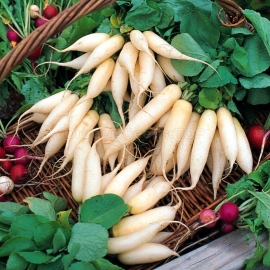


«White Icicle» - Organic Radish Seeds
1.14 €
One of the most easily grown home garden vegetables. Radish 'White Icicle' is a uniform strain which forms long pure snow-white roots. Growing to around 15cm (6in) long, they are the shape of an icicle. The white flesh is crisp and mild.
-
Organic Radish «White Icicle»
One of the most easily grown home garden vegetables. Radish 'White Icicle' is a uniform strain which forms long pure snow-white roots. Growing to around 15cm (6in) long, they are the shape of an icicle.
The white flesh is crisp and mild and less pungent than that of the round varieties, they have a spice that warms the tongue, but doesn’t bite back. They add crispness and spice to salads and appetisers and are great with fish and seafood.
Radish 'Long White Icicle' is ready for harvest only about 25 days after planting. It is a spring radish, perfect for folks who want a crop in hand by the time the first robin sings. While radishes are a cool-season crop usually planted in early spring, icicle radishes are more heat tolerant and also suitable for planting in early summer.
Like all radishes, icicle radishes are easy to grow even in a postage-stamp sized garden with well-drained soil and plenty of bright sunlight. Plant a small crop every two weeks to guarantee a continuous harvest.
How to Grow
Radishes are cool-season vegetables that produce the smaller, sweeter vegetables in spring. There are early season and late season varieties of radish. Start the late season radishes in late summer to early fall for a crop of larger, more pungent globes. Radish seed germination does not require any special pre-treatment and will occur when the seeds are sown on top of the soil or with just a dusting of cover.
Container gardening radishes requires a wide gallon pot and well-drained soil with rich organic amendments. Use a vegetable starter mix, or make your own with a combination of compost and peat mixed with a small amount of sand or other grit. Mix in a vegetable fertilizer before planting to jump start root growth after radish seed germination. Ensure that the pot you choose has a good drainage hole and use unglazed pots that encourage evaporation of excess moisture. If you use a saucer, make sure it is not filled with water constantly.
